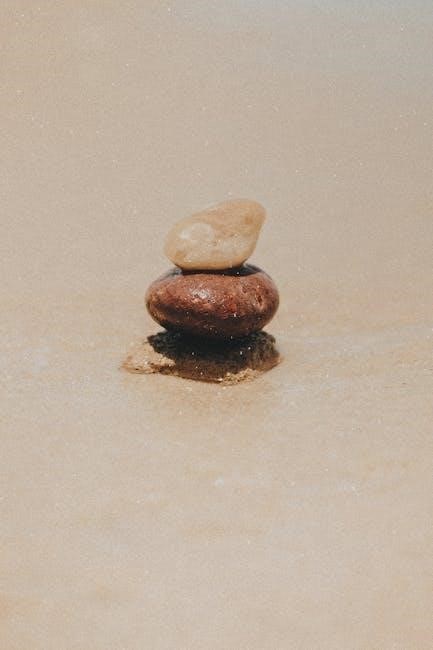Sand tray therapy is a therapeutic technique using miniatures and sand to express emotions nonverbally. It helps individuals construct a personal world‚ exploring feelings and experiences.
1.1 Definition and Overview
Sand tray therapy is a form of expressive therapy that allows individuals to create a three-dimensional representation of their inner world using sand‚ water‚ and miniatures. This hands-on approach enables nonverbal communication‚ making it accessible to people of all ages. The therapy involves constructing scenes in a sand tray‚ which serves as a symbolic space for emotional expression and exploration. It is particularly effective for those who struggle with verbalizing their feelings. The process is deeply personal‚ offering a safe environment for self-discovery and healing. Therapists often use this technique to help clients process trauma‚ anxiety‚ and other emotional challenges‚ fostering growth and insight.
1.2 History and Development
Sand tray therapy originated in the 1930s with Margaret Lowenfeld‚ a British physician‚ who developed the “World Technique.” She introduced the concept of using sand and miniatures to explore a client’s inner world. Later‚ Dora Kalff expanded on this by creating “sandplay‚” emphasizing its therapeutic potential. The technique gained popularity in the 1950s and 1960s as psychologists began recognizing its value in nonverbal communication. Over time‚ sand tray therapy has evolved‚ incorporating various approaches and being adapted for different populations. Its development reflects a blend of psychoanalytic and humanistic principles‚ making it a versatile and enduring therapeutic tool.
1.3 Key Figures in Sand Tray Therapy
Margaret Lowenfeld pioneered sand tray therapy with her “World Technique‚” enabling clients to express unconscious thoughts through sand and miniatures. Dora Kalff expanded this by developing sandplay‚ emphasizing therapeutic healing. Other notable figures include Charlotte Bühler and Hedda Bolgar‚ who contributed to its psychological applications. Their work laid the foundation for modern practices‚ influencing therapists to integrate sand tray techniques into various therapeutic settings. These key figures have shaped the evolution of sand tray therapy‚ making it a respected and effective therapeutic approach globally.

Theoretical Underpinnings of Sand Tray Therapy
Sand tray therapy is rooted in the “World Technique” by Margaret Lowenfeld and Dora Kalff’s sandplay‚ emphasizing nonverbal expression and unconscious exploration through symbolic miniatures.

2.1 The World Technique by Margaret Lowenfeld
Margaret Lowenfeld’s World Technique is a cornerstone of sand tray therapy‚ enabling clients to create symbolic worlds in sand‚ reflecting inner experiences. This method‚ developed in the 1930s‚ allows individuals to express emotions and conflicts nonverbally through miniatures‚ fostering self-discovery and healing. Lowenfeld’s approach emphasizes the therapeutic value of play‚ providing a safe space for exploration and insight. By analyzing the client’s sand tray creations‚ therapists gain deeper understanding of unconscious thoughts and feelings‚ facilitating meaningful interventions and personal growth.
2.2 Dora Kalff’s Approach to Sandplay
Dora Kalff’s approach to sandplay expanded on Margaret Lowenfeld’s World Technique‚ offering a deeper‚ non-directive method. Kalff emphasized the therapeutic relationship and the sand tray as a “mirror of the psyche.” Her work integrated Jungian concepts‚ focusing on the process of creation and exploration rather than interpretation. Kalff believed sandplay allowed clients to access unconscious material‚ fostering healing and self-discovery. Her technique encouraged clients to freely explore symbols and themes‚ promoting emotional expression and integration. Kalff’s contributions remain foundational‚ influencing modern sand tray therapy practices and emphasizing the transformative power of sandplay in therapeutic settings.
2.3 Humanistic Principles in Sand Tray Therapy
Humanistic principles emphasize personal growth‚ self-actualization‚ and empathy‚ aligning closely with sand tray therapy’s client-centered approach. This perspective views clients as inherently capable of self-directed healing‚ with the therapist acting as a supportive facilitator. Sand tray therapy’s nonverbal nature fosters a non-judgmental space‚ encouraging clients to explore emotions and experiences authentically. By focusing on the client’s unique journey‚ humanistic principles empower individuals to gain insight and achieve emotional balance. This approach creates a collaborative environment‚ honoring the client’s autonomy and inner wisdom‚ making it a powerful tool for personal transformation and self-discovery in therapy.

Sand Tray Therapy Techniques
Sand tray therapy employs techniques like directed interventions‚ nonverbal communication with miniatures‚ reflection‚ and wet/dry sand methods to help clients express emotions and resolve inner conflicts creatively.
3.1 Directed Sandtray Interventions
Directed sandtray interventions involve specific prompts guiding clients to create scenes in the sand‚ such as depicting family dynamics or a typical day. These structured activities help therapists explore underlying emotions and experiences. School-age children often benefit from themes like friendships or family‚ while adolescents may explore identity challenges. Directed interventions encourage focus and depth‚ aiding in diagnosis and treatment of various mental health conditions. Over 100 creative ideas exist for these interventions‚ fostering therapeutic creativity and engagement. Reflection and open questioning enhance the process‚ making it valuable once trust is established.
3.2 Nonverbal Communication through Miniatures
Miniatures in sand tray therapy serve as tools for nonverbal expression‚ allowing clients to communicate emotions and experiences symbolically. By selecting and arranging objects like animals‚ people‚ or abstract figures‚ individuals convey unconscious thoughts and feelings. This method bypasses verbal limitations‚ making it especially effective for children or those with difficulty articulating emotions. The variety of miniatures offers diverse representations‚ enabling clients to explore complex themes. The process of choosing and placing miniatures in the sand tray creates a visual narrative‚ which the therapist interprets to understand the client’s inner world. This nonverbal dialogue fosters deep insight and healing in a safe‚ creative environment.
3.3 The Role of Reflection and Open Questioning
Reflection and open questioning are integral to sand tray therapy‚ enhancing the therapeutic process. Reflection involves the therapist acknowledging and mirroring the client’s actions and emotions‚ fostering trust and understanding. Open questioning encourages clients to explore their sand tray creations‚ revealing deeper meanings. This approach helps clients gain insight into their feelings and experiences. The therapist’s non-directive questions prompt clients to connect with their inner world‚ promoting self-discovery and healing. This method ensures clients feel supported and empowered‚ guiding them toward personal growth and emotional resolution.
3.4 Wet and Dry Sand Techniques
Wet and dry sand techniques are fundamental in sand tray therapy‚ offering distinct therapeutic benefits. Wet sand allows clients to shape and mold‚ creating three-dimensional sculptures‚ while dry sand is ideal for precise arrangements. Margaret Lowenfeld’s World Technique introduced both methods‚ enabling clients to express emotions and experiences uniquely. Wet sand fosters creativity and tactile engagement‚ while dry sand encourages detailed storytelling. These techniques provide a versatile medium for self-expression‚ helping clients explore unconscious thoughts and emotions. The contrast between wet and dry sand allows for varied therapeutic approaches‚ making sand tray therapy adaptable to diverse client needs and therapeutic goals.
Benefits of Sand Tray Therapy
Sand tray therapy promotes emotional healing‚ enhances nonverbal communication‚ and reduces stress. It empowers clients to process trauma‚ explore identities‚ and gain self-awareness in a safe‚ creative environment.
4.1 Emotional Expression and Healing
Sand tray therapy offers a powerful tool for emotional expression and healing. By creating a three-dimensional representation of their inner world‚ clients can process complex emotions nonverbally. The tactile experience of sand and miniatures allows individuals to externalize feelings‚ gaining clarity and insight. This form of therapy is particularly effective for those who struggle to articulate their emotions verbally. Through symbolic expression‚ clients can confront and resolve deep-seated issues‚ fostering personal growth and emotional resilience. The safe‚ creative environment of sand tray therapy encourages authenticity‚ enabling meaningful healing and transformation. It is especially beneficial for processing trauma‚ anxiety‚ and other emotional challenges.
4.2 Enhancing Nonverbal Communication
Sand tray therapy excels at enhancing nonverbal communication‚ allowing clients to express emotions and thoughts through symbolic representations. By arranging miniatures in the sand‚ individuals can convey complex feelings that may be difficult to articulate verbally. This method is particularly effective for children‚ trauma survivors‚ and those with limited verbal expression. The nonverbal nature of sand tray therapy creates a safe space for self-expression‚ fostering deeper emotional understanding. It bridges communication gaps‚ enabling therapists to interpret and address underlying issues. This approach not only enhances personal insight but also strengthens therapeutic connection‚ making it a powerful tool for diverse populations seeking emotional and psychological healing.
4.3 Stress Reduction and Relaxation
Sand tray therapy is a calming and meditative process that promotes stress reduction and relaxation. The tactile experience of manipulating sand and miniatures provides a soothing outlet for tension. Engaging in this hands-on activity allows individuals to focus on the present moment‚ fostering mindfulness and emotional release. The rhythmic motion of shaping the sand can lower stress hormones‚ such as cortisol‚ and create a sense of grounding. This technique is particularly beneficial for individuals dealing with anxiety‚ trauma‚ or overwhelming emotions. By offering a safe and creative space‚ sand tray therapy helps individuals unwind and reconnect with their inner self‚ enhancing overall well-being.

Applications of Sand Tray Therapy

Sand tray therapy is widely used with children‚ adolescents‚ and adults‚ addressing various mental health needs and promoting emotional healing through creative expression and nonverbal communication.
5.1 Use with Children and Adolescents
Sand tray therapy is particularly effective with children and adolescents‚ offering a nonverbal medium for self-expression. It helps them explore emotions‚ develop social skills‚ and address challenges like family dynamics or school issues. Directed activities‚ such as building a tray about their family or typical day‚ encourage creativity and insight. This approach allows young clients to communicate complex feelings that may be difficult to articulate verbally‚ fostering emotional healing and growth. Therapists often find it invaluable for diagnosing and treating various mental health conditions in younger populations‚ making it a versatile tool in both individual and group therapy settings.
5.2 Adult Therapy and Self-Exploration
Sand tray therapy is a powerful tool for adults‚ offering a creative outlet for self-reflection and emotional processing. It allows individuals to explore unconscious thoughts‚ process trauma‚ and navigate life transitions. Adults can use miniatures and sand to symbolize inner conflicts‚ desires‚ or unresolved issues‚ gaining insights into their emotional states. Directed interventions‚ such as creating a tray representing life challenges‚ foster deeper self-awareness. This nonverbal approach complements traditional talk therapy‚ enabling adults to express complex emotions and work toward healing and personal growth. Sand tray therapy’s versatility makes it an effective modality for adult self-exploration and therapeutic progress.
5.3 Group Therapy Settings
Sand tray therapy can be effectively integrated into group therapy‚ fostering collaboration and collective healing. Participants create individual or shared sand trays‚ encouraging mutual understanding and empathy. Directed activities‚ such as building a communal tray‚ promote teamwork and communication. This modality helps participants share experiences‚ process emotions‚ and gain diverse perspectives. Group settings enhance social skills and reduce feelings of isolation‚ as individuals witness others’ creative expressions. Sand tray therapy in groups also allows therapists to observe dynamics‚ facilitating deeper insights and group cohesion. This approach is particularly beneficial for addressing shared challenges and fostering a supportive community environment.

Directed Sandtray Activities for Specific Populations
Directed sandtray activities tailor therapeutic exercises to diverse groups‚ addressing unique needs. Techniques include family dynamics for children‚ identity exploration for adolescents‚ and trauma processing for adults.
6.1 School-Age Children: Family and Friend Dynamics
Sand tray therapy effectively engages school-age children by exploring family and friend dynamics. Directed activities include building trays representing their family‚ friends‚ or a typical day. Miniatures help children express complex emotions nonverbally‚ fostering communication and problem-solving skills. This technique allows children to process feelings about sibling relationships‚ peer interactions‚ or school experiences in a safe‚ creative environment. By constructing scenarios‚ children gain insight into social dynamics and emotional challenges‚ promoting self-awareness and healthy development. Sand tray therapy is particularly valuable for helping children navigate interpersonal conflicts and build resilience through imaginative expression. It offers a playful yet meaningful way to address their emotional and social needs.
6.2 Adolescents: Exploring Identity and Challenges
Sand tray therapy offers adolescents a unique way to explore identity and navigate life challenges. Directed activities encourage them to express emotions and experiences through symbolic representations. Miniatures help adolescents convey complex feelings about self-discovery‚ peer relationships‚ and transitions. This method allows them to process struggles like body image‚ academic pressure‚ or family conflicts in a nonverbal‚ creative space. Sand tray therapy fosters self-reflection‚ helping adolescents gain clarity and resilience. It provides a safe environment to address emotional turmoil and develop coping strategies‚ making it an effective tool for supporting adolescents during critical developmental phases and aiding in their journey toward self-understanding and emotional growth.
6.3 Adults: Processing Trauma and Life Transitions
Sand tray therapy provides adults with a powerful tool to process trauma and navigate life transitions. By creating symbolic representations in the sand‚ adults can explore complex emotions and experiences. Directed activities encourage the expression of unresolved issues‚ such as grief or relationship challenges‚ through nonverbal communication. The sand tray serves as a safe space for adults to confront and heal from traumatic events‚ fostering self-awareness and emotional release. This method is particularly effective for those struggling to articulate their feelings verbally. Sand tray therapy helps adults gain insight‚ develop coping strategies‚ and find meaning during significant life changes‚ promoting personal growth and resilience.
Case Studies and Success Stories
Sand tray therapy has proven effective in school settings and with traumatized clients‚ offering a safe space for emotional expression and healing through nonverbal communication.
7.1 Sand Tray Therapy in School Settings
Sand tray therapy has been successfully implemented in schools to support students’ emotional well-being. By creating a safe environment‚ children can express feelings and experiences through sand and miniatures. Directed interventions‚ such as building scenes about family or daily routines‚ help children process challenges. This nonverbal approach is particularly effective for those who struggle with verbal communication. Schools report improved social skills and problem-solving abilities among participants. Additionally‚ sand tray therapy fosters creativity and relaxation‚ making it a valuable tool for school counselors and therapists to address various student needs effectively.
7.2 Sandplay with Traumatized Clients
Sandplay therapy has proven effective in supporting traumatized clients by providing a nonverbal outlet for processing distressing experiences. The sand tray serves as a safe space for clients to recreate and explore traumatic events symbolically. Miniatures allow them to express emotions and themes that may be difficult to articulate verbally. Therapists use reflection and open questioning to help clients gain insight and heal. This approach reduces stress and anxiety while fostering emotional processing. Sandplay also empowers clients to rebuild a sense of control and narratives around their trauma‚ making it a powerful tool in trauma recovery and therapeutic healing.
Getting Started with Sand Tray Therapy
Getting started involves gathering a sand tray‚ wet and dry sand‚ and various miniatures. Setup and training are crucial for effective therapy sessions.

8.1 Essential Materials and Setup
To begin sand tray therapy‚ you’ll need a sturdy sand tray‚ preferably with a blue interior to mimic water. Use both wet and dry sand for versatility. Include a variety of miniatures like animals‚ people‚ and objects to symbolize different aspects of life. Water should be available for wet sand techniques. Position the tray in a quiet‚ comfortable space with good lighting; Ensure miniatures are easily accessible. Proper setup creates a conducive environment for clients to express themselves freely‚ fostering therapeutic exploration and emotional healing through nonverbal communication.
8.2 Training and Resources for Therapists
Therapists interested in sand tray therapy can access various training programs and resources. Workshops and online courses provide hands-on experience with techniques and theoretical foundations. Essential materials include sand trays‚ miniatures‚ and guidebooks like Sandtray Therapy: A Practical Manual. Literature by Margaret Lowenfeld and Dora Kalff offers deeper insights. Joining professional organizations and attending conferences can enhance skills and networking. Additionally‚ downloadable PDF guides and case studies are available for practical application. These resources help therapists integrate sand tray therapy effectively into their practice‚ ensuring they are well-equipped to support clients in their therapeutic journey.
Sand tray therapy continues to grow‚ offering new techniques and expanded applications. Its effectiveness in mental health makes it a promising tool for future therapeutic innovations and research.
9.1 The Growing Popularity of Sand Tray Therapy
Sand tray therapy is gaining traction globally due to its versatility and effectiveness. Therapists increasingly adopt it for diverse populations‚ from children to adults‚ recognizing its nonverbal communication benefits. The technique’s hands-on nature allows clients to express emotions deeply‚ fostering healing and self-discovery. Its application in schools‚ clinical settings‚ and group therapy highlights its broad appeal. As mental health awareness grows‚ sand tray therapy is becoming a preferred method for many practitioners‚ offering a creative and empathetic approach to treatment. This trend is expected to continue‚ solidifying its place in modern therapeutic practices.
9.2 Innovations in Sandplay Techniques
Sandplay techniques are evolving with creative adaptations‚ expanding their applications. Therapists now integrate approaches like CBT and mindfulness‚ enhancing outcomes. New materials‚ such as digital tools‚ are being introduced‚ and wet and dry sand combinations allow for deeper emotional exploration. Cultural adaptations make the therapy more accessible and inclusive. Ongoing research continues to validate its effectiveness‚ ensuring sandplay remains a dynamic and relevant therapeutic method for modern mental health care.